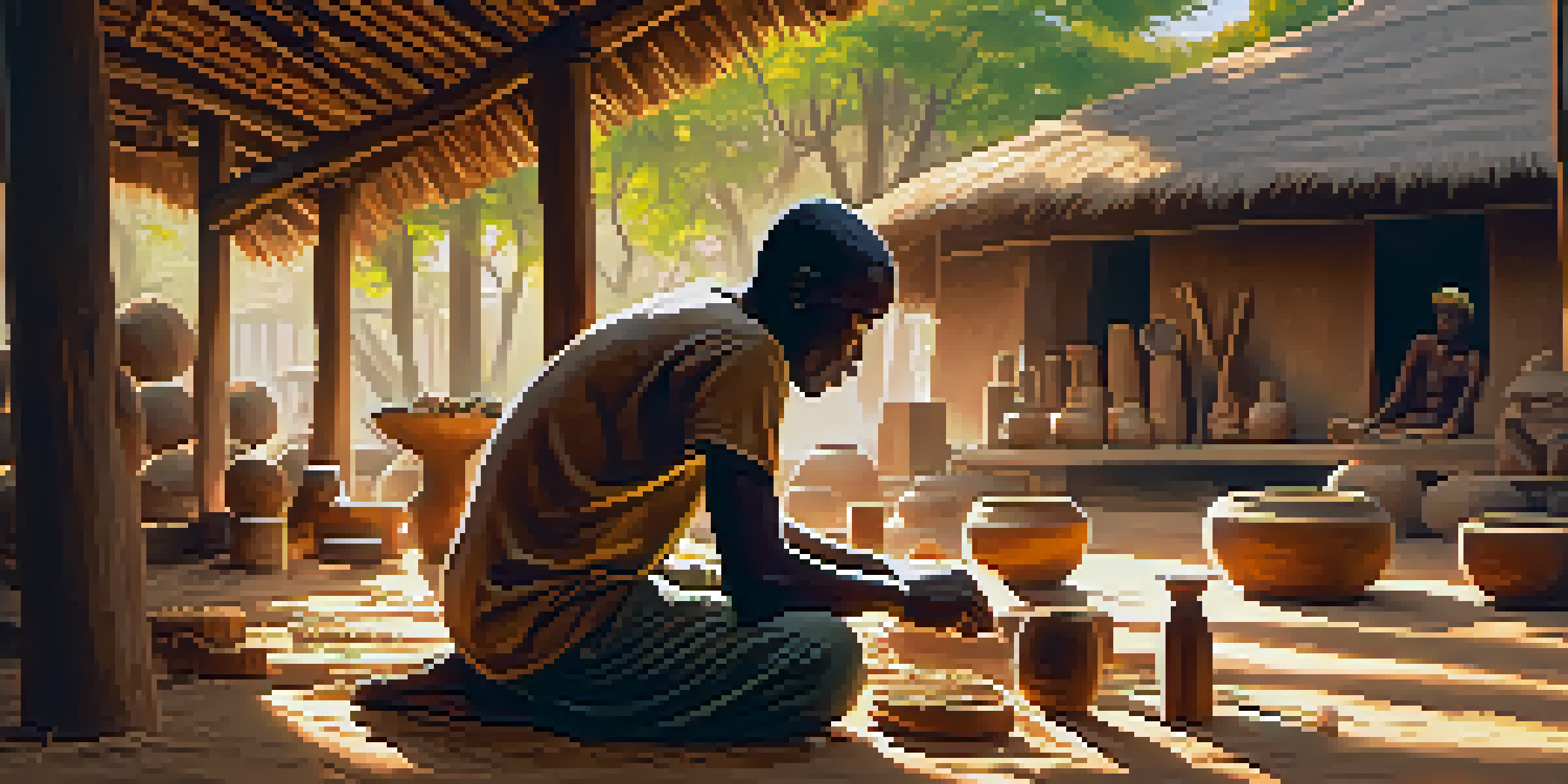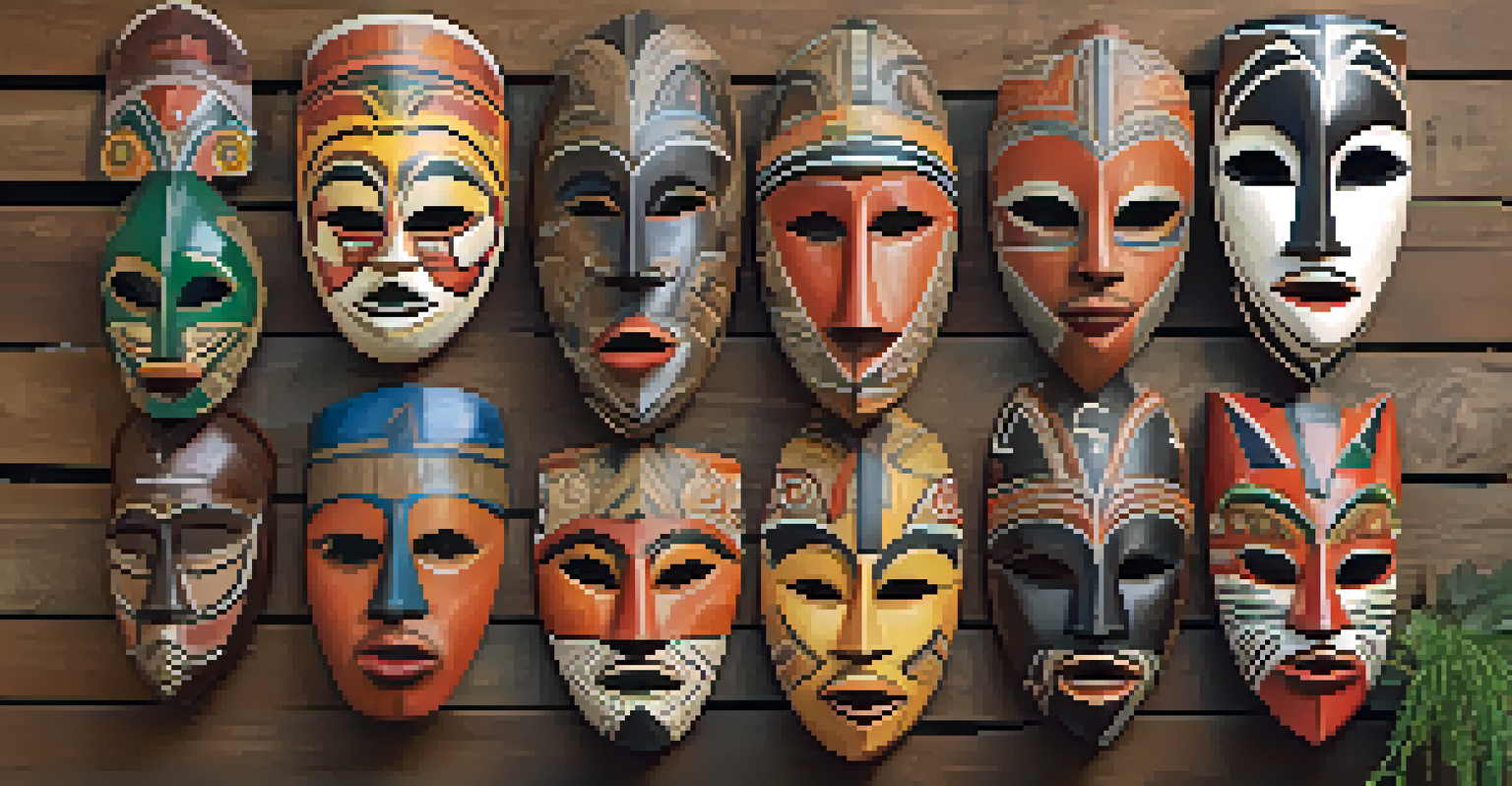African Wood Carving: Traditions and Techniques Explored

An Overview of African Wood Carving Traditions
African wood carving is a remarkable art form deeply rooted in cultural traditions. Each piece tells a story, reflecting the beliefs, values, and history of the community it originates from. These carvings often serve functional purposes, such as masks for rituals or utensils for daily use, making them integral to everyday life.
Art is the most beautiful of all lies.
The art of wood carving varies widely across Africa, with each region showcasing distinct styles and methods. For instance, the intricate designs from the Akan people of Ghana differ significantly from the bold, abstract forms found in the woodwork of the Yoruba in Nigeria. This diversity highlights the rich tapestry of cultures across the continent.
Traditionally, these carvings are made from local hardwoods, such as mahogany and ebony, prized for their durability and beauty. The selection of wood is not just practical but also symbolic, as different types of wood may hold different meanings within various cultures.
The Spiritual Significance of Wood Carving
Wood carving in Africa often transcends mere aesthetics; it carries profound spiritual significance. Many carvings are created for ceremonial purposes or as offerings to deities, making them an essential part of spiritual practices. For instance, masks may be worn during rituals to embody ancestral spirits and connect the physical world with the spiritual realm.

The symbolism embedded in these carvings can vary greatly depending on the culture. Some carvings represent fertility, while others might symbolize strength or protection. This deep connection to spirituality adds layers of meaning that enhance the appreciation of the artistry involved.
Cultural Heritage in Wood Carving
African wood carving reflects the beliefs and values of various communities, serving both functional and artistic purposes.
Artisans often undergo extensive training, learning from their elders not just the techniques of carving but also the spiritual stories behind each piece. This mentorship ensures that the cultural significance of the carvings is preserved and passed down through generations.
Techniques Used in African Wood Carving
The techniques employed in African wood carving are as diverse as the cultures themselves. Carvers often use hand tools, such as chisels and knives, to create intricate designs and patterns. The skillful manipulation of these tools requires years of practice, leading to the creation of stunningly detailed works.
The best way to predict the future is to create it.
One common technique is relief carving, where designs are carved into the surface of the wood, creating a three-dimensional effect. This technique allows for depth and texture, bringing the carving to life. Another technique, called hollowing, is used to create masks and sculptures that resonate with the spirit they represent.
In addition to traditional methods, modern influences have begun to shape contemporary African wood carving. Some artisans are experimenting with new materials and tools, blending traditional styles with modern artistic expressions, which keeps the craft vibrant and evolving.
Regional Variations in Wood Carving Styles
Africa is home to a plethora of distinct wood carving styles, each reflecting the unique cultural heritage of its region. For instance, the Makonde people of Tanzania are famous for their intricate, elongated figures that often depict family relationships and stories. Their carvings are not just artistic expressions but also convey social messages.
In West Africa, the Baule people of Côte d'Ivoire are known for their highly stylized masks that are used in various ceremonies. These masks often feature exaggerated facial features and vibrant colors, showcasing the carver's creativity and cultural narratives. Each region's style serves as a visual language that communicates the community's values and beliefs.
Spiritual Connection and Symbolism
Many carvings hold spiritual significance, often representing concepts like fertility and protection tied to cultural rituals.
Moreover, the differences in materials and techniques used across regions contribute to the diversity in styles. For instance, in the northern regions, carvers may utilize softer woods that allow for more intricate detailing, while southern artisans might focus on more robust forms suited to their environment.
The Role of Women in Wood Carving
While traditionally viewed as a male-dominated craft, women have played a significant role in the art of wood carving across Africa. Many women are skilled artisans, creating beautiful pieces that reflect their experiences and cultural narratives. Their contributions are vital to preserving and innovating the craft.
In some communities, women carve items that are specifically associated with feminine roles, such as utensils or decorative pieces for the home. These creations often embody themes of fertility, family, and nurturing, connecting the art form to their identities and experiences as women.
Furthermore, women are increasingly taking on leadership roles within the craft, establishing cooperatives and workshops. This empowerment not only enhances their skills but also promotes sustainability and community development through the sharing of knowledge and resources.
Preserving Traditional Techniques in a Modern World
As globalization continues to influence various art forms, preserving traditional wood carving techniques has become increasingly important. Many artisans face challenges such as competition from mass-produced items and the loss of cultural heritage. Efforts are underway to ensure that these traditional skills do not fade away.
Workshops and training programs are being established to teach younger generations about the craft. These initiatives often involve elders sharing their knowledge and expertise, creating a bridge between the past and the future. This mentorship is crucial for keeping the traditions alive and relevant.
Women’s Impact on the Craft
Women are increasingly recognized as vital contributors to wood carving, creating pieces that embody their cultural narratives and experiences.
Additionally, many artisans are turning to digital platforms to showcase their work, reaching a broader audience. By sharing their stories and the cultural significance of their pieces online, they can foster appreciation and support for traditional wood carving in a contemporary context.
The Future of African Wood Carving
The future of African wood carving looks promising, with a blend of tradition and innovation paving the way forward. Young artisans are exploring new styles and techniques, infusing modern aesthetics while respecting their cultural roots. This evolution keeps the art form dynamic and engaging for both creators and audiences.
Furthermore, as awareness of the cultural significance of wood carving grows, so does the demand for authentic pieces. This shift has the potential to provide economic opportunities for artisans, allowing them to thrive while continuing their craft. Supporting these creators not only helps preserve their art but also uplifts their communities.

As we look ahead, it's essential to celebrate and promote African wood carving as a vital art form. By recognizing its historical and cultural significance, we can ensure that this unique tradition continues to inspire and connect people for generations to come.